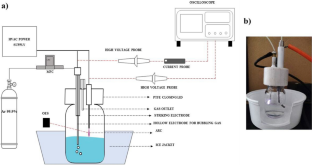Plasma Chemistry and Plasma Processing ( IF 3.6 ) Pub Date : 2024-01-11 , DOI: 10.1007/s11090-023-10439-3 Bhavadharini Boopathy , Debapriya Mukherjee , V. Nishanth , Atish Roy Chowdhury , Dipshikha Chakravortty , Lakshminarayana Rao

|
Understanding the individual effects of species in plasma activated water (PAW) is indeed necessary for its selective application as an antimicrobial agent. The current study describes a setup and a methodology to generate species-specific high strength PAW at neutral pH. Three types of PAW i.e., ROS-rich PAW (Reactive Oxygen Species-rich Plasma Activated Water), RNS-rich PAbW (Reactive Nitrogen Species- Rich Plasma Activated buffer Water) and hs-PAbW (High strength Plasma Activated buffer Water) were generated in the developed set-up, the concentration of species was measured, shelf-life studies under ambient condition were carried out and each water type was studied for its antimicrobial activity. Results show that, after 60 min of activation, hs-PAbW had ROS and RNS concentrations of 215 mg/l and 650 mg/l respectively. The ROS-rich PAW had ROS and RNS concentration of 218 mg/l and 0 mg/l respectively. The RNS-rich PAbW had ROS and RNS concentration of 16 mg/l and 858 mg/l respectively after 60 min of activation. Antimicrobial studies showed that individual species i.e., high concentrations of ROS alone and high concentrations of RNS alone, were ineffective in achieving microbial degradation, whereas hs-PAbW containing high concentrations of both ROS and RNS showed significant antimicrobial effect. This study marks an important step in generating high concentrations of species-specific PAW, which is crucial to understand the mechanistic pathways of bacterial death in PAW systems.
中文翻译:

中性pH下物种特异性高强度等离子体活化水的生成及其抗菌特性
了解等离子体活化水(PAW)中物种的个体效应对于其作为抗菌剂的选择性应用确实是必要的。当前的研究描述了在中性 pH 值下生成物种特异性高强度 PAW 的设置和方法。生成了三种类型的 PAW,即富含 ROS 的 PAW(富含活性氧物质的等离子体活化水)、富含 RNS 的 PAbW(富含活性氮物质的等离子体活化缓冲水)和 hs-PAbW(高强度等离子体活化缓冲水)在开发的装置中,测量了物种的浓度,进行了环境条件下的保质期研究,并研究了每种水类型的抗菌活性。结果显示,激活 60 分钟后,hs-PAbW 的 ROS 和 RNS 浓度分别为 215 mg/l 和 650 mg/l。富含 ROS 的 PAW 的 ROS 和 RNS 浓度分别为 218 mg/l 和 0 mg/l。激活 60 分钟后,富含 RNS 的 PAbW 的 ROS 和 RNS 浓度分别为 16 mg/l 和 858 mg/l。抗菌研究表明,单独的物种,即单独的高浓度ROS和单独的高浓度RNS,不能有效实现微生物降解,而同时含有高浓度ROS和RNS的hs-PAbW显示出显着的抗菌作用。这项研究标志着产生高浓度物种特异性 PAW 的重要一步,这对于了解 PAW 系统中细菌死亡的机制途径至关重要。



























 京公网安备 11010802027423号
京公网安备 11010802027423号